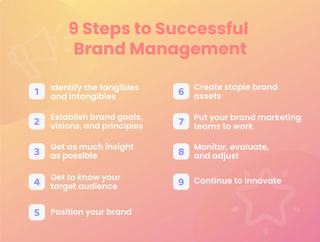The Ultimate Guide to Brand Management

Brand management: Set the stage for years of success
These days, it's not enough to have a single clever marketing campaign. While they can temporarily boost engagement and recognition, success is fleeting in a crowded market. Consumers see an onslaught of advertisements every day, and countless brands are vying for their business. It's so saturated that many people have ad blindness!
But do you know which marketing attempts stand out regardless of how many ads people see? It's the ones with strong brand management. Think about it: Apple, Mcdonald's, Coke, Geico, and more have instantly recognizable branding that you can often identify without seeing a single company name. How do they do it? Through careful brand management.
Brand management is about building and maintaining a strong perceived value beyond products or services. It involves building recognition, developing a solid reputation, and putting tons of weight behind a brand name.
Keep reading to learn more about brand asset management and what you can do to take your marketing efforts to the next level!
What is brand management?
You might have heard this term thrown around marketing circles. But what is brand management?
To put it simply, it's a function of marketing that focuses more on the brand as a whole rather than an individual product. Your company is more than a single product offering. Even if you're in the startup phase and have only one thing customers can buy, the goal is to be more than that, right?
It's about the long game! You want to develop a reputation that exceeds a defining product or service. The goal is to create so much high brand awareness and customer loyalty that it positively affects how you do business later. Good brand management can turn into an instant identifier that transcends a single campaign.
Think about some of your favorite brands. Take McDonald's as an example. The chain has a vast menu of products that changes pretty frequently. However, those iconic golden arches and that simple "I'm Lovin' It" jingle are consistent. The same goes for Coca-Cola's signature colors, that beloved Nike swoop, or all of Apple's minimalistic marketing choices.
Those companies built their reputation over years of carefully messaging and brand management, and it paid off!
What is brand asset management?
A key part of proper brand management is ensuring that those elements which make up your brand identity are properly managed. Your brand assets are everything that would go into your brand style guide: your logo, tone of voice, design assets, and even your brand story. Anything that you have collected which makes up your brand identity online and offline is considered a brand asset. These assets have to be carefully managed to ensure consistency in both design and messaging. Often these elements are scattered across departments and file storage services, leading to a lack of coherency when it comes to brand guidelines. By using a brand asset management system, you can keep all your brand assets in one location for anyone to access, ensuring consistency at every touchpoint and across all channels. With Collato’s brand style guide template, for example, you can store all your designs, fonts, logos, and important documents and keep track of ownership and iterations as well as share curated versions of your brand assets with external parties.
Why does brand management matter?
The brand management definition revolves around building awareness. But it's so much more than that! Solid management strategies can snowball, resulting in a slew of great benefits.
Stand out in a crowded market
The most obvious perk of brand management? Brand recognition. We can't stress enough how important it is to stand out from a super-crowded market.
It's more challenging than ever to grab a consumer's attention. Advertisements surround us! They're on billboards, on the subway, on our phones, and more. Everywhere you look, there's a company trying to sell you something. Modern consumers have become so used to that inundation that they learn to adapt and ignore engagement as much as possible.
But when it comes to recognizable brands, it's different. A carefully managed brand strategy is familiar and comforting to consumers. Take a look at a busy photo of Times Square, the Las Vegas strip, or any other billboard-heavy area. There's a good chance that the first ads you'll notice are for big-name companies with solid brand management.
Brand loyalty and the all-important CLV
CLV stands for Customer Lifetime Value. It's a metric that measures how much business you can reasonably expect from a single customer. The goal for any company is to achieve a super high CLV because it indicates that customers will return.
There's no better way to build brand loyalty and increase the CLV than through brand management. People know what to expect when you deliver a consistent customer experience and uniform messaging across the board. This keeps your customers coming back!
With every product launch, they're there to support you. Eventually, your brand becomes more than a company. It becomes part of a customer's life.
Boost brand equity and the bottom line
We can't talk about the definition of brand management without mentioning brand equity. Management strategies can significantly improve brand equity over time. Why does that matter?
When shopping in the grocery store, are you more likely to go with generic products or brand names you know? If you're like most, you'll go with the latter branded choice.
Brand equity is the value your name creates. Think of companies like Apple. People are willing to pay a premium for Apple-branded products. The same goes for any designer fashion brand.
Do things right, and brand management can significantly boost the bottom line, increase sales, and create considerable revenue.
Brand management vs. brand marketing
Before we go any further, let's talk about the difference between brand management and brand marketing. Many use these two terms interchangeably, but they're very different things.
Management is the ongoing process of maintaining a consistent brand image. Think of it as the lengths you go to create consistency in your campaigns. It's what you do to build brand equity and stand out from the competition.
Meanwhile, brand marketing is putting everything to use. Brand marketing is about developing individual campaigns and marketing materials that adhere to the management strategy guidelines. If brand management is the blueprint, brand marketing is the process of building the house.
These two concepts go hand-in-hand, but brand management is responsible for creating the overall brand and maintaining the consistency you need for continued success.
9 steps to successful brand management
Ready to put all the pieces together? Brand management takes time. It's an ongoing effort. While you can start to build your house of success pretty quickly, the real payoff doesn't come until much later.
But fear not! Putting brand management to use now can make a world of difference in the company's success moving forward. Here are some simple steps to develop a solid brand strategy.

1. Identify the tangibles and intangibles
First things first, let's talk about tangible and intangible brand assets. Tangible properties are the things you can easily touch and change. That includes the product itself, packaging, logos, and all the fun parts of marketing.
The intangible properties are details you can't touch or immediately. We're talking about customer experience, how people feel about your brand, and what kinds of emotions your products create. The intangible aspects build brand equity.
When creating a brand management strategy, consider how tangible and intangible assets fit into the narrative. You need to figure out these basics first to determine how you make it happen.
2. Establish brand goals, visions, and principles
Here's where you'll need to dig a little deeper.
What is it that your brand is trying to do? What's the overall goal, and what do you envision for the company? Figuring out this step will involve multiple stakeholders, but it's crucial to shaping your brand strategy.
3. Get as much insight as possible
Now we can get into the fundamentals: insight is a must.
Do market research to see how your current marketing strategies are paying off. This step is about learning as much about the competition, where your brand lies now, and what you can do to improve.
Data doesn't lie, and it can do a lot to guide you in the right direction.
4. Get to know your target audience
This step is similar to the previous one, but it focuses on your target audience. Figure out core demographics and begin segmenting your audience into different personas. Map out the buyer's journey and establish touch points that you can use when implementing marketing campaigns.
Brand management is about putting your name out there and making an impact. Knowing your customers will let you do just that.
5. Position your brand
Where does your brand fit into the larger market? Will you appeal to trendsetters and shakers, or will you stick to mass-market appeal? What about price point and value?
Understanding where your brand fits into the bigger picture is paramount. As mentioned earlier, the market is already crowded. Finding that niche that works for your company's values and goals helps you hone in on strategies that stick.
6. Create staple brand assets
Finally, we get to the asset creation. This step in the process involves creating brand assets like logos and slogans. It's when you'll choose colors and other details that you want to associate with your brand.
Consistency is vital, so brand asset management is a must. These assets will appear in most of your campaigns moving forward, so take time to create assets that deliver the punch you want.
7. Put your brand marketing teams to work
After you have the assets in place, the next step is to let your marketing teams create content!
Brand management will help you maintain consistency across the board, but your marketing efforts don't have to be identical. Let your marketing teams get creative with content planning while sticking to the guidelines you created earlier.
8. Monitor, evaluate, and adjust
Even after your content is published and your campaign is at the end phase, continue to monitor performance. See how people perceive your brand and continue to refine strategies.
It takes time to get things perfect. Don't be afraid to tweak guidelines until you find that sweet spot that people love. Never rest on your laurels, and always go back to the engagement metrics to see what people think.
9. Continue to innovate
Last but not least, continue to innovate. The companies with the best brand management strategies always push the envelope. Just because you have a strict image in place doesn't mean you can't think outside the box!
The last thing you want is for your brand to get stale. Keep churning out ideas and evolve with your target audience.
Setting the stage for success
Brand management is all about the long game. Don't get discouraged if you don't see immediate results. Continue improving your management strategies and grow with the changing market.
Over time, you'll gain loyal customers who develop a deeper connection to your brand. They'll stick with you and contribute to your success. Who knows? Your efforts now could be the start of something iconic in the future!
